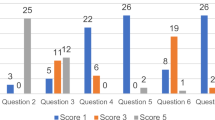Abstract
Background
YouTube™ is the foremost source of videos of all kinds of issues.
Objectives
The aim of this study was to investigate videos related to accelerated orthodontic treatment on YouTube™ in terms of characteristics, content, popularity and viewers’ assessments.
Methods
Six keywords related to accelerated orthodontic treatment were searched on YouTube™. After sorting by view-count, all 116 videos were evaluated, and the exclusion criteria were defined as: another language than English, unrelated to the topic, poor video quality and duplication. The remaining 80 videos were analyzed for general characteristics, primary purpose, information content, audio-visual quality. Also, viewers’ interaction index, and viewing rate formulas were calculated for each video.
Results
The final 80 videos were viewed by users for 177,328 times in total. Most videos were uploaded by an educational institution (n = 40; 50.0%), followed by orthodontists (n = 20; 25.0%). Most of the videos (51.25%) were classified as having excellent general information content, 30.00% were rated as moderate, and 18.75% were rated as poor. The videos generally involved educational content (47.50%), followed by product presentation (20.00%), and then technical details about accelerated orthodontics (11.25%). Only 6.25% of the videos (n = 5) had viewers’ interaction index values of greater than 3.00. Videos with excellent content had significantly higher interaction index values than others (p < 0.001).
Conclusions
YouTube™ could be preferred as an important source for patient information about accelerated orthodontics. Reliable informative videos should be uploaded by orthodontists or dental professionals in accelerated orthodontics.

Similar content being viewed by others
References
Bizzi I, Ghezzi P, Paudyal P (2017) Health information quality of websites on periodontology. J Clin Periodontol 44:308–314
Gazit-Rappaport T, Haisraeli-Shalish M, Gazit E (2010) Psychosocial reward of orthodontic treatment in adult patients. Eur J Orthod 32:441–446
Yavuz MC, Sunar O, Buyuk SK et al. (2018) Comparison of piezocision and discision methods in orthodontic treatment. Prog Orthod 19:44
Charavet C, Lecloux G, Bruwier A, et al. (2016) Localized piezoelectric alveolar decortication for orthodontic treatment in adults: a randomized controlled trial. J Dent Res 95:1003–1009
Alikhani M, Raptis M, Zoldan B et al. (2013) Effect of micro-osteoperforations on the rate of tooth movement. Am J Orthod Dentofac Orthop 144:639–648
Al-Silwadi FM, Gill DS, Petrie A et al. (2015) Effect of social media in improving knowledge among patients having fixed appliance orthodontic treatment: a single-center randomized controlled trial. Am J Orthod Dentofac Orthop 148:231–237
Sorensen JA, Pusz MD, Brietzke SE (2014) YouTube as an information source for pediatric adenotonsillectomy and ear tube surgery. Int J Pediatr Otorhinolaryngol 78:65–70
Hegarty E, Campbell C, Grammatopoulos E, et al. (2017) YouTube™ as an information resource for orthognathic surgery. J Orthod 44:90–96
Hassona Y, Taimeh D, Marahleh A, et al. (2016) YouTube as a source of information on mouth (oral) cancer. Oral Dis 22:202–208
Singh AG, Singh S, Singh PPJ (2012) YouTube for information on rheumatoid arthritis--a wakeup call? Rheumatol 39:899–903
Oremule B, Patel A, Orekoya O et al. (2019) Quality and reliability of YouTube Videos as a source of patient information on rhinoplasty. JAMA Otolaryngol Head Neck Surg 145:282–2873
Carneiro B, Dizon DS (2019) Prostate cancer social media: In YouTube We Trust? Eur Urol 75:568–569
ElKarmi R, Hassona Y, Taimeh D (2017) YouTube as a source for parents’ education on early childhood caries. Int J Paediatr Dent 27:437–443
Richter AE, Arruda AO, Peters MC (2011) Incidence of caries lesions among patients treated with comprehensive orthodontics. Am J Orthod Dentofac Orthop 39:657–664
Patterson BM, Dalci O, Darendeliler MA (2016) Corticotomies and orthodontic tooth movement: a systematic review. J Oral Maxillofac Surg 74:453–473
Knösel M, Jung K (2011) Informational value and bias of videos related to orthodontics screened on a video-sharing Web site. Angle Orthod 81:532–539
Lena Y, Dindaroğlu F (2017) Lingual orthodontic treatment: A YouTube™ video analysis. Angle Orthod 88:208–214
Author information
Authors and Affiliations
Corresponding author
Ethics declarations
Conflict of interest
The authors declare that they have no conflict of interest.
Ethics, consent, and permissions
This study did not require approval by the local research ethics committee as it involved publicly available data only.
Additional information
Publisher’s note
Springer Nature remains neutral with regard to jurisdictional claims in published maps and institutional affiliations.
Rights and permissions
About this article
Cite this article
Yavuz, M.C., Buyuk, S.K. & Genc, E. Does YouTube™ offer high quality information? Evaluation of accelerated orthodontics videos. Ir J Med Sci 189, 505–509 (2020). https://doi.org/10.1007/s11845-019-02119-z
Received:
Accepted:
Published:
Issue Date:
DOI: https://doi.org/10.1007/s11845-019-02119-z




